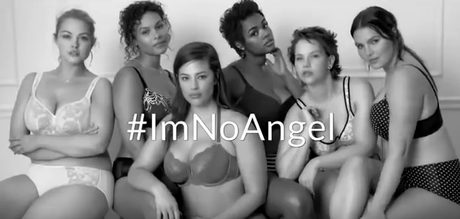
via YouTube: https://www.youtube.com/watch?v=RwxYW6mlTPk
When I recently opened the September issue of Vogue, I was (for once) surprised by what I found. Hidden in the midst of 832 pages of fashion coverage was a 2-page ad featuring plus-size models dramatically silhouetted behind the words “It’s time for change” and “#PlusIsEqual.” They were, perhaps unsurprisingly, the only plus size models I noticed featured in the issue.
This ad is just one installment of a campaign recently launched by clothing retailer Lane Bryant. The first was the #ImNoAngel campaign, which launched in April of this year and featured models posing in Lane Bryant’s line of lingerie to prove women don’t have to look like Victoria’s Secret models to be sexy. The campaign has since grown and aims to increase visibility for women of all sizes in the media and given that the majority of women in the U.S. — 67% — wear sizes 14 to 34, it seems long overdue for an ad campaign to accurately and deliberately mirror this reality. What’s more, the models not only more accurately represented the women likely viewing the ad in terms of size, but also in terms of skin tone – the diverse ad is a much-needed counterpoint to the continuing prevalence of white celebrities.
While some see Lane Bryant’s campaign as a bold, deliberate attempt to redefine beauty, affirm women in popular culture and end unrealistic beauty standard — and are responding in kind to the campaign on social media —others argue it doesn’t go far enough. For example, Ajay Rochester, an Australian actress and author, started the #DropThePlus campaign soon after Lane Bryant began #ImNoAngel and continued with #PlusIsEqual. She argues that calling women “plus size models” is stigmatizing and leads to bullying, even as curvy women are increasingly landing modeling contracts.
It’s also disappointing that a body positive campaign had to come from Lane Bryant, a long-time plus-size retailer. What if a “normal” clothing line had started using models of size and released a similar statement? Considering that just this past summer legislation in France that would have created a minimum weight threshold for professional models and criminalized hiring dangerously thin women was struck down, such efforts are still apparently necessary.
Ideally, though, such campaigns and size distinctions would be altogether unnecessary. All models and all women should be seen as “normal” rather than be subjected to labels that differentiate them from others based on their size alone. That models are seemingly fetishized based on polarized extremes — they can either be hyper-thin or plus-sized — has been especially challenging for me as someone recovering from disordered eating and body-image issues. #PlusIsEqual is encouraging, but not entirely relatable to my attempt to grapple with what “average” and “normal” mean for me and more broadly. Widespread use of models of a vast range of sizes would do much to foster acceptance of women across the complete spectrum of body shapes and weights.
But, realistically, it may take a while for this inclusive understanding of beauty to become the norm in the modeling industry. Until then, #PlusIsEqual is undeniably important because it subtly attacks fat-shaming and elevates a group of women who have been sidelined for too long. While, just like most other feminist issues, there is still much work to do, the joy, relief and empowerment that has emerged in response to #PlusIsEqual can’t be discredited and may be the start of a major change.

